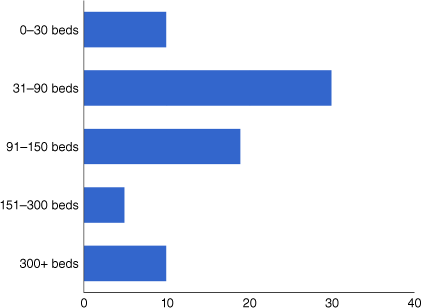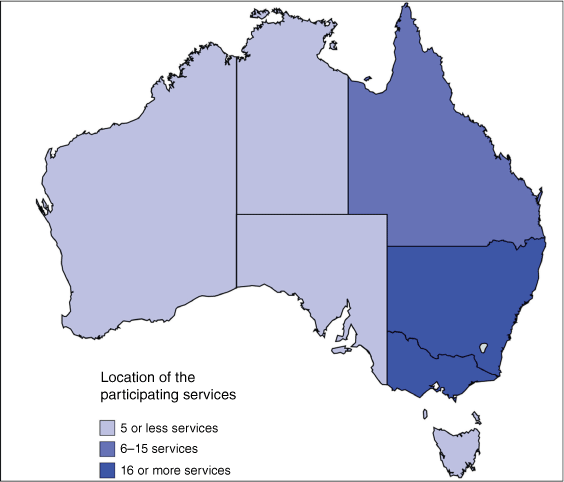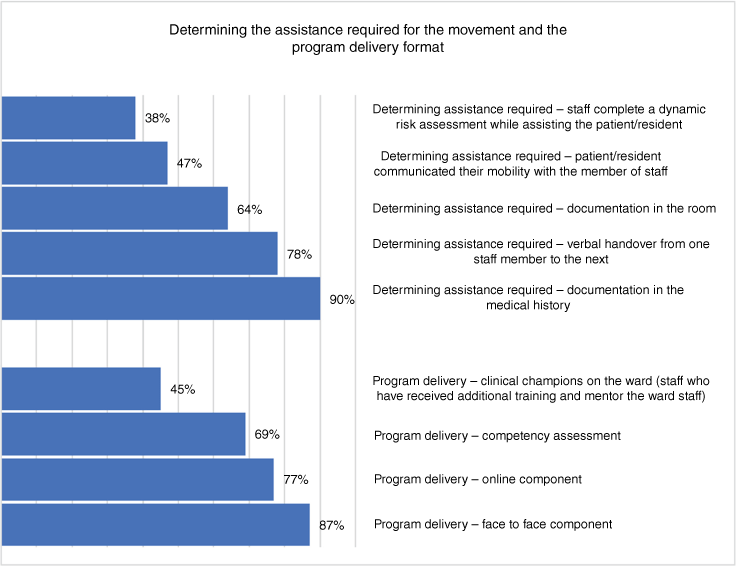In Australian hospitals and residential aged care facilities, how do we train nursing and direct care staff to assist patients and residents to move? A national survey
Natasha Brusco A * , Terry Haines B , Nicholas F. Taylor C D , Helen Rawson E , Leanne Boyd F , Christina Ekegren
A * , Terry Haines B , Nicholas F. Taylor C D , Helen Rawson E , Leanne Boyd F , Christina Ekegren  A , Helen Kugler G , Helen Dawes H , Camilla Radia-George I , Christine Graven A and Keith Hill A
A , Helen Kugler G , Helen Dawes H , Camilla Radia-George I , Christine Graven A and Keith Hill A
A Rehabilitation, Ageing and Independent Living (RAIL) Research Centre, Monash University, Vic., Australia.
B School of Primary and Allied Health Care, Monash University, Vic., Australia.
C Allied Health Clinical Research Office, Eastern Health, Box Hill, Vic. Australia.
D School of Allied Health Human Services and Sport, La Trobe University, Vic., Australia.
E Nursing and Midwifery, Monash University, Vic., Australia.
F Nursing and Midwifery, and Teaching and Learning, Eastern Health, Box Hill, Vic., Australia.
G Clinical Education and Research Institute, Cabrini Health, Malvern, Vic. Australia.
H College of Medicine, Department of Public Health & Sports Sciences, Faculty of Health and Life Sciences, Intersect@Exeter, University of Exeter, UK.
I Health, disability, counselling and mental health services, EACH, Ringwood, Vic, Australia.
Australian Health Review 47(3) 331-338 https://doi.org/10.1071/AH22296
Submitted: 23 December 2022 Accepted: 23 April 2023 Published: 22 May 2023
© 2023 The Author(s) (or their employer(s)). Published by CSIRO Publishing on behalf of AHHA. This is an open access article distributed under the Creative Commons Attribution-NonCommercial-NoDerivatives 4.0 International License (CC BY-NC-ND)
Abstract
Objective Nursing workplace injuries related to staff-assisted patient/resident movement occur frequently, however, little is known about the programs that aim to prevent these injuries. The objectives of this study were to: (i) describe how Australian hospitals and residential aged care services provide manual handling training to staff and the impact of the coronavirus disease 2019 (COVID-19) pandemic on training; (ii) report issues relating to manual handling; (iii) explore the inclusion of dynamic risk assessment; and (iv) describe the barriers and potential improvements.
Method Using a cross-sectional design, an online 20-min survey was distributed by email, social media, and snowballing to Australian hospitals and residential aged care services.
Results Respondents were from 75 services across Australia, with a combined 73 000 staff who assist patients/residents to mobilise. Most services provide staff manual handling training on commencement (85%; n = 63/74), then annually (88% n = 65/74). Since the COVID-19 pandemic, training was less frequent, shorter in duration, and with greater online content. Respondents reported issues with staff injuries (63% n = 41), patient/resident falls (52% n = 34), and patient/resident inactivity (69% n = 45). Dynamic risk assessment was missing in part or in whole from most programs (92% n = 67/73), despite a belief that this may reduce staff injuries (93% n = 68/73), patient/resident falls (81% n = 59/73) and inactivity (92% n = 67/73). Barriers included insufficient staff and time, and improvements included giving residents a say in how they move and greater access to allied health.
Conclusion Most Australian health and aged care services provide clinical staff with regular manual handling training for staff‐assisted patient/resident movement, however, issues with staff injuries, as well as patient/resident falls and inactivity, remain. While there was a belief that dynamic in‐the‐moment risk assessment during staff‐assisted patient/resident movement may improve staff and resident/patient safety, it was missing from most manual handling programs.
Keywords: allied health, hospital, manual handling, nursing, occupational health and safety, patient, resident, residential aged care.
Introduction
Of the 1.8 million Australians working in health care and social assistance in 2019/20, 22 000 experienced a severe workplace injury that resulted in a serious workers’ compensation claim (12.3 per 1000 employees),1 representing a 31% increase in annual claims compared to 2000/01.1 Compared to other workers, nurses experience an extremely high rate of workers’ compensation claims (28.7 per 1000 employees), with half attributed to body-stressing injuries,2 which is not unexpected as nurses report that manual handling is in everything they do.3 These work-based compensation claims contribute to the long-term nursing workforce shortage crisis in Australia,4 which has intensified during and post the coronavirus disease 2019 (COVID-19) pandemic.5,6
There is a paucity of literature reporting on manual handling training interventions with demonstrated ability to reduce nurses’ musculoskeletal injuries in the workplace.7,8 This may be explained by the plethora of literature that has consistently refuted a causal relationship between nurses lower back pain and the repeated daily task of assisting patients with movement.9,10 Nursing compensation claims data from Safe Work Australia indicates that the mechanism of injury is most often a traumatic event, such as a traumatic soft tissue injury or muscle strain during a single task (62%; n = 25 000 2003/04–2013/14), compared to cumulative non-traumatic back pain or strains (5%; n = 2000; 2003/04–2013/14).2
Despite the year-on-year increase in serious workplace injuries for nurses in Australia,1 little is known about the training schedules, content, characteristics, gaps and impact of manual handling programs for nursing and direct care staff in Australian hospitals and residential aged care services. For example, we do not know how many manual handling programs upskill participants in dynamic risk assessment, defined as a continual in-the-moment assessment of factors that impact a healthcare process,11 or how many manual handling programs effectively change clinical practice at the bedside, such as the Risk Assessment for moving Individuals SafEly (RAISE)3 program. While the concept of risk assessment for manual handling is not new, many controlled studies examining patient manual handling programs do not specifically refer to risk assessment in the program description.12–15
The aims of this study were to: (i) describe how Australian hospitals and residential aged care services provide manual handling training programs for nursing and direct care staff and the impact of the COVID-19 pandemic on the training programs; (ii) report issues relating to manual handling; (iii) explore the inclusion of dynamic risk assessment in current manual handling training programs; and (iv) describe the barriers and potential improvements to manual handling programs to better prevent staff injuries and patient/resident falls, while promoting patient/resident participation in movement.
Methods
This project was approved by the Monash University Human Research Ethics Committee (Project ID: 31866) and has been reported in accordance with the Checklist for Reporting Results of Internet E-Surveys (CHERRIES).16 Participants were staff at hospitals and residential aged care facilitates across Australia who had knowledge of the organisation’s manual handling program for nursing and direct care staff. There were no exclusion criteria.
Using social media (twitter), emails and snowballing, an open online survey was distributed to hospitals and aged care services across Australia, aiming to recruit a minimum of 50 respondents for a nationally representative sample. The survey was developed and tested by researchers (NB, CE, TH and KH) prior to fielding the survey. The 20-min survey asked respondents to describe their current manual handling programs for nursing and direct care staff, particularly as it relates to staff-assisted patient/resident movement. Consent for participation was sought at the start of the survey.
The survey was administered on the research electronic data capture (REDCap) platform17,18 with survey responses being entered directly into the database. No data fields were mandatory, and no incentives were offered to participate in the survey. Data were collected between July 2022 and September 2022. There were 51 items across eight pages for the survey (Supplementary Appendix S1). Participants could go back and review/change responses, and at the end of the survey participants were sent a copy of their completed survey via email. IP addresses were reviewed to ensure that there was only one response per hospital or aged care service; where IP addresses doubled up, only the first submitted response would be included.
Hospital and aged care service characteristics were collected, and this included public versus private funding model, the size of the service and geographic location. The survey was then divided into five sections. The first asked respondents to report if staff injuries, patient/resident falls, and patient/resident inactivity were a problem for their organisation. The second asked respondents to detail their current manual handling program and if the COVID-19 pandemic impacted training associated with the program. The third section asked staff about their perception of how well the current program reduced the risk to staff and patients/residents, as well as how the program could be improved. The fourth section focused on dynamic in-the-moment risk assessment and asked staff about the inclusion of this in their current program, and if they believed that the inclusion of dynamic in-the-moment risk assessment during staff-assisted patient/resident movement, does or could reduce staff injuries as well as patient/resident falls and inactivity. The final section focused on identifying the need for support with their manual handling program.
Results were presented for the whole cohort, as well as separately for hospitals and aged care services where possible. Survey results are presented as a number and percentage for categorical data. To understand the staff perspective of their manual handling program, respondents were asked to rate their program on a Likert scale (0 = never; 10 = always), and these results were reported as a median with an interquartile range. As responses to questions were not compulsory, it was expected that the denominator for some questions may be less than the total number of respondents. Open-ended questions regarding suggestions for improvement to current manual handling programs have been categorised and reported as a count.
Results
Respondents from 75 different hospitals (n = 18/72) and aged care services (n = 63/72) across Australia participated in the survey (noting nine identified as both a hospital and an aged care service, and three did not respond to this question). Across the services, 81% (n = 58/72) provided residential aged care and 13% (n = 9/72) provided specialist residential aged care (for example for First Nations people or for people with a mental health condition). In addition, 22% (n = 16/72) provided acute hospital care, 17% (n = 12/72) provided rehabilitation hospital care, and 11% (n = 8/72) provided hospital care for people with a mental health condition. Due to the majority of the included hospitals also providing an aged care service, we were not able to report the results for hospitals and aged care separately.
Funding for the services included a combination of public (78% n = 58/74) and private (39% n = 29/74), noting some reported receiving both public and private funding. The most common size of the services 31–90 beds (Fig. 1), with service location spread across Australia (Fig. 2).
Respondents indicated that across the services (n = 74) there was a combined 73 000 staff who assist patients/residents to mobilise. Staff who assist the patient/resident to mobilise include registered nurses (100% n = 74/74), personal care attendants (92% n = 68/74), enrolled nurses (84% n = 62/74), physiotherapists (82% n = 61/74), allied health assistants (41% n = 30/74), occupational therapists (38% n = 28/74), volunteers (23% n = 17/74) and doctors (20% n = 15/74). The staff who were reported to most frequently document the patient/resident mobility status were registered nurse (95% n = 70/74), physiotherapist (91% n = 67/74), enrolled nurse (55% n = 41/74), occupational therapist (41% n = 30/74), personal care attendant (26% n = 19/74), and allied health assistant (19% n = 14/74). It was reported that patient/resident mobility was reviewed as required (80% n = 58/73), monthly (38% n = 28/73), each shift (19% n = 14/74), daily (11% n = 8/73), weekly (6% n = 4/74), or not routinely reviewed (1% n = 1).
Most respondents reported staff attended manual handling training at commencement of employment (85% n = 63/74), as well as annual refresher courses (88% n = 65/74); however, one service did not provide any manual handling training (1%). Components of manual handling training programs, as well as communication methods to guide how much support to provide the patient/resident when assisting movement, are presented in Fig. 3. All services (100% n = 74/74) had a monitoring system to track how many staff completed their manual handling training, and most training was facilitated by a combination of nurses, physiotherapists, and occupational health and safety officers.
Compared to 2019, there was a perception by respondents that during the 2020–2022 COVID-19 pandemic, manual handling training was shorter in duration (27% n = 20/74), that refresher training was offered less frequently to staff (43% n = 32/74), and that the training was provided more online (50% n = 37/74). Respondents reported that during the COVID-19 pandemic, some programs had the competency assessment removed (17% n = 11) and that other programs had a competency assessment added (21% n = 14). A third of services reported no change to the manual handling training during the COVID-19 pandemic (32% n = 21).
With respect to current issues, respondents reported that during staff-assisted patient/resident movement, there was a problem with staff injuries (66% n = 48/73); as well as patient/resident falls (52% n = 38/73) and inactivity (73% n = 53/73) (Fig. 4).
Number of respondents reporting problems relating to staff injuries, and patient/resident falls and inactivity during staff-assisted patient/resident movement.
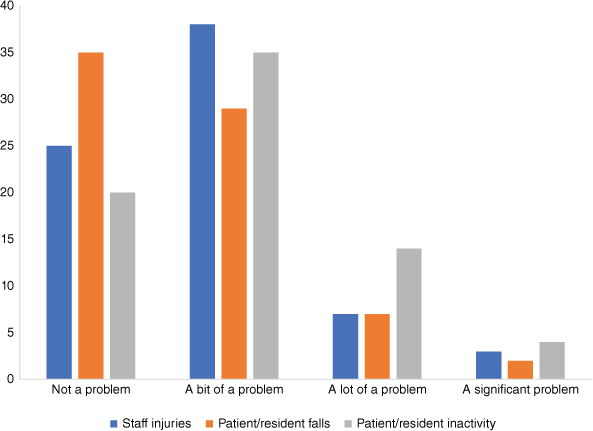
Most respondents indicated that dynamic risk assessment was missing in part, or in whole, from their current staff manual handling program (92%; n = 67/73). Most respondents also believed that upskilling staff in dynamic risk assessment can prevent staff musculoskeletal injuries (93%; n = 68/73), prevent patient/resident falls (81%; n = 59/73) and enable the patient/resident to participate in movement to the best of their ability (92%, n = 67/73). Regarding patient/resident inactivity, most respondents agreed with the following statement ‘maintaining a good level of patient mobility and independence is an essential part of care delivery and can reduce the risk of long-term physical and psychological effects’19 (99%; n = 72/73). Most participants also reported they were likely to review (88%; n = 64/73) and/or implement (73%; n = 53/73) a training package on dynamic risk assessment during staff-assisted movement, if made freely available.
Respondents were then asked a series of question on a Likert scale (0 = never; 10 = always) regarding aspects of their manual handling program. The answers had a full range of responses from 0 to 10, with the median value ranging from 5 to 7 (Table 1). Lower ratings (median 5–6) were observed for the questions that asked about the inclusion of dynamic risk assessment in the current manual handling training program.
| Median | IQR (25th, 75th percentile) | Range (minimum, maximum) | |
| How well does the manual handling program teach staff how to prevent staff musculoskeletal injuries? | 7 | 5–8 | 2–10 |
| When staff help patients/residents move, do they move to the best of their ability (i.e. the patient/resident does as much of the movement as possible)? | 7 | 5–8 | 2–10 |
| Does the patient/resident get a say in how they move (i.e. report how they are feeling and how much of the movement they can do by themselves)? | 7 | 6–8 | 2–10 |
| How well does the manual handling program teach staff how to prevent patient/resident falls? | 7 | 5–8 | 0–10 |
| How well does the current patient/resident manual handling program teach staff to complete a dynamic risk assessment of: The manual handling task (e.g. assisting the patient to move in bed, or to walk)? | 5 | 5–8 | 0–10 |
| How well does the current patient/resident manual handling program teach staff to complete a dynamic risk assessment of: The capability and limitations of the patient/resident (e.g. how well the patient can follow instructions and how strong are the patients leg muscles)? | 5 | 3–7 | 0–10 |
| How well does the current patient/resident manual handling program teach staff to complete a dynamic risk assessment of: The capability and limitations of themselves and other staff involved (e.g. pre-existing staff injuries, time constraints)? | 6 | 4–7 | 0–10 |
| How well does the current patient/resident manual handling program teach staff to complete a dynamic risk assessment of: The load of the patient/resident and any equipment being used? | 6 | 5–8 | 0–10 |
| How well does the current patient/resident manual handling program teach staff to complete a dynamic risk assessment of: The environment (e.g. clutter)? | 6 | 5–8 | 0–10 |
Respondents identified multiple barriers impacting the effectiveness of their current manual handling program (Fig. 5). Respondents believed that improvements could be made to the current manual handling programs to better prevent staff injuries (‘yes’ 49% n = 36/73 and ‘maybe’ 47% n = 34/73), patient/resident falls (‘yes’ 66% n = 48/73) and giving patients a greater say in how they move (‘yes’ 60% n = 44/74). There were 125 suggestions for improvement to the current staff manual handling programs (Table 2). Most common responses were ensuring residents in aged care services have a say in how they move, having greater access to allied health, embedding case scenarios into manual handling training as well as ensuring staff have access to regular manual handling refresher training.
Respondents (n = 65) reported the frequency of barriers that impact the effectiveness of their current manual handling program.
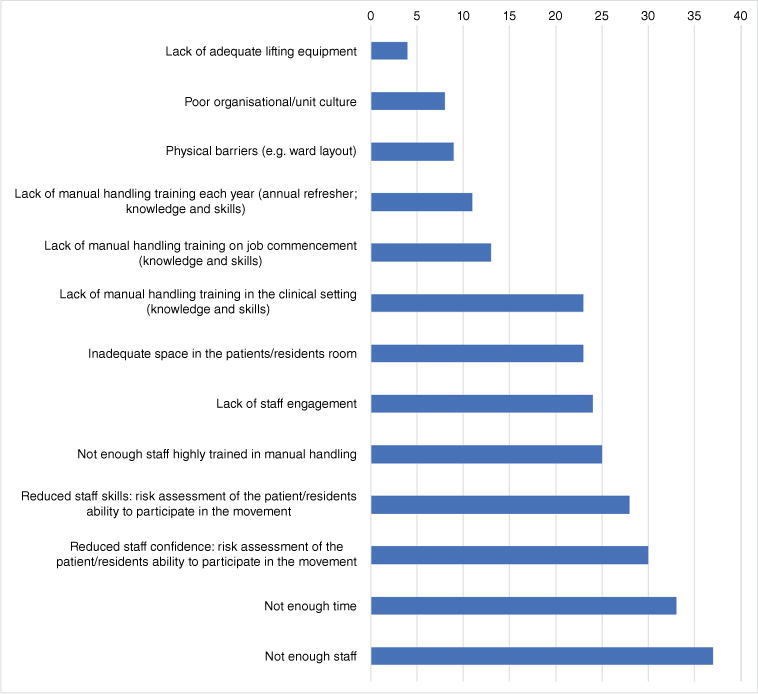
| Count | |
| Ensure residents have a say in how they move in aged care services | 15 |
| Greater access to allied health in residential aged care (assessment and training) | 14 |
| Embed case scenarios into manual handling training | 12 |
| Access to regular manual handling refresher training | 12 |
| Manual handling training – more face to face content and more detail | 12 |
| Upskilling staff in general assessment and dynamic risk assessment skills | 10 |
| Designing training where safe transfers and falls prevention have their own separate focus during training | 9 |
| Transfer of manual handling training into clinical practice at the bedside | 7 |
| Focus on patient ‘ability’ to promote their independence | 6 |
| Higher staffing ratios to support patient/resident mobility | 6 |
| Allow ‘dignity of risk’ for residents to have a say regarding their mobility | 5 |
| Manual handling training – more training on body mechanics | 4 |
| Address staff concerns about resident insight into their own mobility abilities | 4 |
| Improve the staff culture around injury prevention | 3 |
| Provide information on evidenced based falls prevention | 3 |
| Co-design the staff manual handling program with the patient | 1 |
| Ensure there is consistent manual handling training across industry, universities and other registered training organisations | 1 |
| Ensure a coordinated approach to injury prevention research via a national injury prevention data base | 1 |
Finally, at the conclusion of the survey, 81% of respondents (n = 61/75) expressed interest in their hospital and/or residential aged care service joining a staff manual handling community of practice, to keep informed regarding research in this area and to provide an opportunity to share experiences and learnings over time.
Discussion
Across Australia, most nursing and direct care staff in hospitals and residential aged care services participate in manual handling training for staff-assisted patient/resident movement. The training is generally provided on the commencement of employment and then annually as a refresher. Respondents reported that during staff-assisted patient/resident movement, there is a risk of staff injuries, as well as risk of patient/resident falls and inactivity, and that dynamic risk-assessment may reduce these risks. However, dynamic risk assessment was missing in most manual handling programs. Most staff reported that they would likely review and implement a training package on manual handling dynamic risk assessment, if made freely available.
As with all open recruitment surveys, there is potential for recruitment bias relating to those who choose to participate in a survey. For example, hospitals and aged care services with the greatest concerns for their manual handling training program may have been more inclined to complete a survey on the issue. A strength of the study is the recruitment of participants across all Australian states and territories (excluding ACT), as well as a sample size (n = 75) that exceeded the target.
At present, high-level evidence on how to provide manual handling training to effectively reduce staff injuries, and/or reduce patient/resident falls and inactivity, does not exist.7,8,20 While the current study does not provide this evidence, it does provide a snapshot of the variation that exists across Australia regarding manual handling training programs provided to nursing and direct care staff. It also provides insight in the barriers into the provision of manual handling training, as well as suggestions to improve how the training is provided. This feedback from the respondents, combined with the evidence available, can be used in the design and evaluation of future manual handling training programs.
Based on the literature that has consistently refuted a causal relationship between nurses lower back pain and the repeated daily task of assisting patients with movement,9,10 it is hypothesised that the mechanism of injury is often attributed to a single traumatic event, such as a traumatic soft tissue injury or muscle strain. An example of this is seen in the nursing compensation claims data from Safe Work Australia indicates the mechanism of injury is most often attributed to a traumatic event (62%), compared to cumulative non-traumatic back pain or strains (5%).2 As such, any new approach to preventing nursing staff injuries during patient/resident assisted movement, should base itself upon this mechanism of injury, and focus on avoiding traumatic events through skilled and dynamic risk assessment, before, during and after patient/resident assisted movement.
With most respondents from the hospitals and aged care services identifying that dynamic risk assessment was missing from their current staff manual handling programs, future research is required to determine if the introduction of dynamic risk assessment into staff manual handling training will reduce staff injuries, patient/resident falls, and increase the opportunity for patients/residents to participate in movement, as was the belief of the respondents. Due to the majority of the included hospitals also providing an aged care service, we were not able to report the results for hospitals and aged care separately, which is a limitation of the study. While the findings of this study are only applicable in the Australian public and private hospital and aged care context, the international generalisability of these findings is going to be explored through a planned future study that will replicate this survey through distribution to health and aged care services in the United Kingdom.
Conclusion
The time has come to critically review staff manual handling training programs in hospitals and residential aged care services across Australia. Many of the current programs do not include dynamic risk assessment, despite the widespread belief that this skill may reduce staff injuries and patient/resident falls and improve patient/resident participation in movement.
Data availability
The data that support this study will be shared upon reasonable request to the corresponding author.
Declaration of funding
This project was funded by the 2022 Advancing Women in Research Grant from Monash University, awarded to NB. HD is supported by the NIHR Exeter Biomedical Research Centre. The views expressed are those of the authors and not necessarily those of the NIHR, NHS or the UK Department of Health and Social Care.
Author contributions
NB: conceptualisation, methodology, formal analysis, writing original, review and editing, and funding acquisition. TH: conceptualisation, methodology, review and editing. NT: conceptualisation, methodology, review and editing. HR: conceptualisation, methodology, review and editing. LB: conceptualisation, review and editing. CG: methodology, writing review and editing. CE: methodology, writing review and editing. HK: methodology, writing review and editing. HD: methodology, writing review and editing. KH: conceptualisation, methodology, review and editing.
Acknowledgements
The authors would like to acknowledge the respondents across the hospitals and aged care services who participated in this study.
References
[1] Safe Work Australia. Australian Workers Compensation Statistics. 2020. Available at https://www.safeworkaustralia.gov.au/media-centre/news/australian-workers-compensation-statistics-2019-20#:~:text=Safe%20Work%20Australia%20has%20published%20the%20Australian%20workers%E2%80%99,of%20serious%20claims%20were%20for%20illness%20and%20diseases [accessed August 2022].[2] Gray S, Collie A. Workers’ Compensation Claims Among Nurses and Ambulance Officers in Australia, 2008/09–2013/14.. Melbourne: Monash University, ISCRR; 2016 May. 26 p. Report No.: 118-0516-R03.
[3] Kugler HL, Taylor NF, Boyd L, et al. Nurses sustain manual handling risk assessment behaviours six-months after a training program to move patients safely: a pre-post study. Disabil Rehabil 2022; 45 927–935.
| Nurses sustain manual handling risk assessment behaviours six-months after a training program to move patients safely: a pre-post study.Crossref | GoogleScholarGoogle Scholar |
[4] Mannix K. The future of Australia’s nursing workforce: COVID-19 and burnout among nurses. 2021. Available at https://www.unimelb.edu.au/__data/assets/pdf_file/0004/4085194/katelyn_mannix_report.pdf
[5] Lowman GH, Harms PD. Editorial: Addressing the nurse workforce crisis: a call for greater integration of the organizational behavior, human resource management and nursing literatures. J Manag Psychol 2022; 37 294–303.
| Editorial: Addressing the nurse workforce crisis: a call for greater integration of the organizational behavior, human resource management and nursing literatures.Crossref | GoogleScholarGoogle Scholar |
[6] Chan G, Bitton J, Allgeyer R, et al. The impact of COVID-19 on the nursing workforce: a national overview. Online J Issues Nurs 2021; 26 Manuscript 2
| The impact of COVID-19 on the nursing workforce: a national overview.Crossref | GoogleScholarGoogle Scholar |
[7] Richardson A, McNoe B, Derrett S, et al. Interventions to prevent and reduce the impact of musculoskeletal injuries among nurses: A systematic review. Int J Nurs Stud 2018; 82 58–67.
| Interventions to prevent and reduce the impact of musculoskeletal injuries among nurses: A systematic review.Crossref | GoogleScholarGoogle Scholar |
[8] Verbeek J, Martimo KP, Karppinen J, et al. Manual material handling advice and assistive devices for preventing and treating back pain in workers: A Cochrane systematic review. Occup Environ Med 2012; 69 79–80.
| Manual material handling advice and assistive devices for preventing and treating back pain in workers: A Cochrane systematic review.Crossref | GoogleScholarGoogle Scholar |
[9] Roffey DM, Wai EK, Bishop P, et al. Causal assessment of workplace manual handling or assisting patients and low back pain: results of a systematic review. Spine J 2010; 10 639–651.
| Causal assessment of workplace manual handling or assisting patients and low back pain: results of a systematic review.Crossref | GoogleScholarGoogle Scholar |
[10] Kwon BK, Roffey DM, Bishop PB, et al. Systematic review: occupational physical activity and low back pain. Occup Med 2011; 61 541–548.
| Systematic review: occupational physical activity and low back pain.Crossref | GoogleScholarGoogle Scholar |
[11] Li M, Liu Z, Li X, et al. Dynamic risk assessment in healthcare based on Bayesian approach. Reliab Eng Syst Saf 2019; 189 327–334.
| Dynamic risk assessment in healthcare based on Bayesian approach.Crossref | GoogleScholarGoogle Scholar |
[12] Járomi M, Kukla A, Szilágyi B, et al. Back School programme for nurses has reduced low back pain levels: A randomised controlled trial. J Clin Nurs 2018; 27 e895–e902.
| Back School programme for nurses has reduced low back pain levels: A randomised controlled trial.Crossref | GoogleScholarGoogle Scholar |
[13] Warming S, Ebbehøj NE, Wiese N, et al. Little effect of transfer technique instruction and physical fitness training in reducing low back pain among nurses: A cluster randomised intervention study. Ergonomics 2008; 51 1530–1548.
| Little effect of transfer technique instruction and physical fitness training in reducing low back pain among nurses: A cluster randomised intervention study.Crossref | GoogleScholarGoogle Scholar |
[14] Svensson AL, Strøyer J, Ebbehøj NE, et al. Multidimensional intervention and sickness absence in assistant nursing students. Occup Med 2009; 59 563–569.
| Multidimensional intervention and sickness absence in assistant nursing students.Crossref | GoogleScholarGoogle Scholar |
[15] Svensson AL, Marott JL, Suadicani P, et al. Sickness absence in student nursing assistants following a preventive intervention programme. Occup Med 2011; 61 57–61.
| Sickness absence in student nursing assistants following a preventive intervention programme.Crossref | GoogleScholarGoogle Scholar |
[16] Eysenbach G. Improving the quality of Web surveys: the Checklist for Reporting Results of Internet E-Surveys (CHERRIES). J Med Internet Res 2004; 6 e132
| Improving the quality of Web surveys: the Checklist for Reporting Results of Internet E-Surveys (CHERRIES).Crossref | GoogleScholarGoogle Scholar |
[17] Harris PA, Taylor R, Minor BL, et al. The REDCap consortium: Building an international community of software platform partners. J Biomed Inform 2019; 95 103208
| The REDCap consortium: Building an international community of software platform partners.Crossref | GoogleScholarGoogle Scholar |
[18] Harris PA, Taylor R, Thielke R, et al. Research electronic data capture (REDCap)—a metadata-driven methodology and workflow process for providing translational research informatics support. J Biomed Inform 2009; 42 377–381.
| Research electronic data capture (REDCap)—a metadata-driven methodology and workflow process for providing translational research informatics support.Crossref | GoogleScholarGoogle Scholar |
[19] Warren G. Moving and handling: reducing risk through assessment. Nurs Stand 2016; 30 49–58.
| Moving and handling: reducing risk through assessment.Crossref | GoogleScholarGoogle Scholar |
[20] Thomas DR, Thomas YLN. Interventions to reduce injuries when transferring patients: a critical appraisal of reviews and a realist synthesis. Int J Nurs Stud 2014; 51 1381–1394.
| Interventions to reduce injuries when transferring patients: a critical appraisal of reviews and a realist synthesis.Crossref | GoogleScholarGoogle Scholar |


